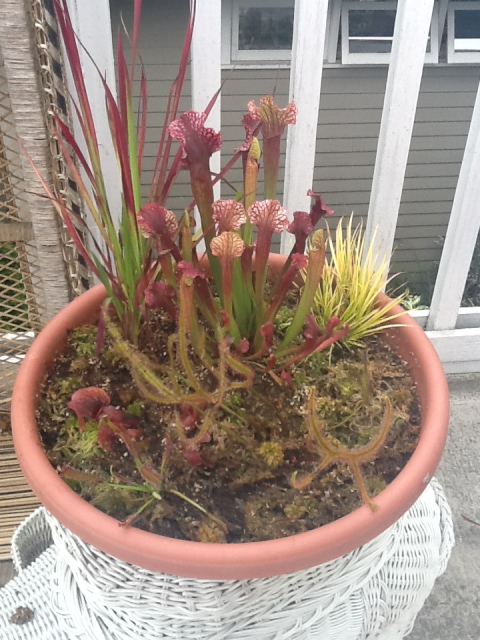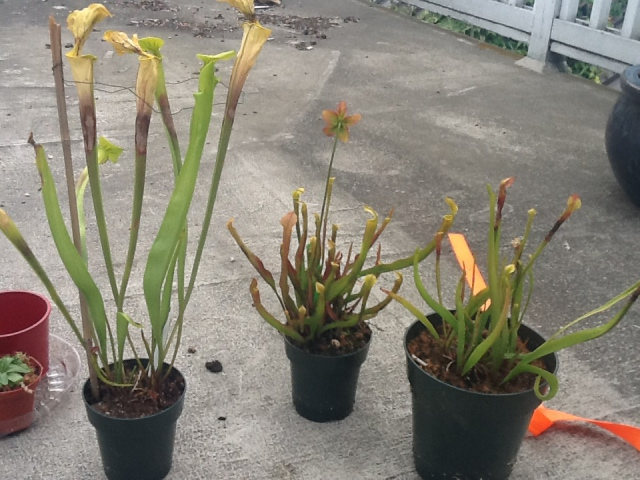Question
 Healthy White Top in B
Healthy White Top in B  Dysfunctional Plants
Dysfunctional Plants
Hey Experts,
I have a wacky problem that I cannot figure out. I live in Seattle. I have become a recent carnivorous plant fanatic and have many plants. Most of collection reside on my upper back deck where it gets lots of sun and is sometimes windy (I think that is important). I received a S. Rubra Canebrake Sweet Pitcher from you last year towards the end of the summer. I put that along with a taller variety of sweet pitcher, a flytrap, and a staghorn sundew into my garage for winter dormancy because I was worried about freezing over the winter on the deck.
I took them out after the frost was gone which may have been late but I don't remember. The plants experienced painfully slow growth. The sundew was the only plant that grew quickly. I even repotted the flytrap but its still growing very slowly. I have further purchased many plants from a local nursery which showed me the extent of the differentiation in the plants. The new ones I bought are massive healthy looking plants while the ones from last year are still tiny, disfigured little pitchers (no where where they were last year at this time).
Here is what I posted before:
An interesting thing that happened was I bought a very nice looking Flava which got a little dried out while i was on vacation but after returning to water and good conditions I realized that the new emerging pitchers were also disfigured and some were winding around.
Many of my plants have tipped over from the wind which obviously effects the Flava greatly since its so tall. Are these windy conditions causing this disfigured growth? I see no pests or fungi on the plants but I could be wrong.
AnswerHi Miles,
Thank-you for the pictures. That really helps. You have a few things going on here. Your wind could be an issue. If you can create a wind block of some kind that will be of benefit, especially for the Flava. Here are some of the other issues:
1. Bug captures. Your plants have been capturing lots of insects, and it's very common later in the summer to see these brown spots develop and even have the top part of the pitcher die. I see several of the pitchers look like this.
2. Specifics of particular Sarracenia species. Your S. flava is an early season grower. It's in that transition stage right now where it is starting to make phyllodia, it's flat non-carnivorous leaves. This happens right about now with most flava varieties. They often start with smaller odd looking pitchers, then transition to just phyllodia in September. This can be influenced some by temperatures too, and the first half of our summer was very cool. Phyllodia production will sometimes come later if the summer hasn't been very warm. Last year was even worse, so the plant may not have had the phyllodia yet when you bought it.
Seasonality also is what appears to be going on with your S. rubra varieties. The S. rubra "Canebrake" is actually Sarracenia rubra subsp. alabamensis. I can't quite tell what the other one is, but it could be a S. rubra subsp. wherryi, or even Sarracenia alata. Both of these plants tend to produce smaller thin pitchers in the early summer, especially when the summer is cool. When it warms up they start making more characteristic pitchers, with the most spectacular leaves in the early fall. The rubra alabamensis often produces beautiful yellow pitchers in September. Ours here in Oregon are just starting to produce some of those now. You're much cooler in the Puget Sound area however, so it will probably be later this month. If the plant on the far right is S. alata, they are notorious for not producing bigger pitchers until it's warmer. It originates in the Gulf Coast, so it is used to very hot summers. Also, I couldn't see any evidence of what I'm about to say in your photos, but both of the rubra varieties are very prone to aphids. If you see twisted and especially crinkly pitchers, that is often aphids and you would need to treat. S. rubra alabamensis is so prone to aphids I often spray them in the late spring preventatively. Overall you should see a change in your plants by the end of the month.
I also wanted to mention that the big Sarracenia in your bowl is actually S. x "Judith Hindle", a hybrid. Judith Hindle is overall a good stout grower that often looks good throughout the season, and even into the winter. It inherited many of the better traits of it's parent plants.
Good Growing!
Jeff Dallas
Sarracenia Northwest
http://www.cobraplant.com







